| Cinematography | Geoffrey Unsworth, BSC |
|---|
| Directed by | Richard Attenborough |
|---|
A Bridge Too Far is a 1977 British-American epic war film based on the 1974 book of the same name by Cornelius Ryan, adapted by William Goldman. It was produced by Joseph E. Levine and Richard P. Levine and directed by Richard Attenborough.
The film tells the story of the failure of Operation Market Garden during World War II. The operation was intended to allow the Allies to break through German lines and seize several bridges in the occupied Netherlands, including one at Arnhem, with the main objective of outflanking German defences in order to end the war by Christmas of 1944.

Operation begins
The airborne drops catch the Germans totally by surprise, and there is little resistance. Most of the men come down safely and assemble quickly, but the Son bridge is blown up by the Germans, just before the 101st Airborne secures it. German Field Marshal Model, thinking that the Allies are trying to capture him, panics and retreats from Arnhem. However, soon after landing, troubles beset Urquhart’s division. Many of the Jeeps either don’t arrive by gliders at all or are shot up in an ambush. Their radio sets are also useless, meaning no contact can be made with either paratroopers moving into Arnhem under Lt. Col. John Frost or XXX Corps. Meanwhile, German forces reinforce Nijmegen and Arnhem. Meanwhile, US Sergeant Eddie Dohun is driving his jeep searching for his commanding officer, Captain Glass. He finds the captain with a bullet in his head and thinking he is alive decides to take him to medical care.

He encounters German troops but manages to avoid them. Arriving at the hospital, Dohun takes the captain to an Army physician (Medical Corps Colonel) who refuses to look at the captain until Dohun threatens to shoot him. The medic manages to get the bullet out of the captain’s skull and says he’ll possibly live. He places Dohun under arrest for 10 seconds as punishment for pointing a gun at him.
XXX Corps’ progress is slowed by German resistance, the narrowness of the highway and the need to construct a Bailey bridge to replace the destroyed bridge at Son. XXX Corps is able to move onto the Grave bridge without much resistance, but is halted at Nijmegen. There, soldiers of the 82nd Airborne Division perform a dangerous daylight river crossing in flimsy canvas-and-wood assault boats. Ultimately, despite heavy casualties the river crossing is successful, and the Nijmegen bridge is captured. The Germans close in on the isolated British paratroopers occupying part of Arnhem at the bridge. Urquhart is separated from his men, and the supply drop zones are overrun by the Germans. German attacks on the paratroopers at the bridge are repelled. British armour continues to fight its way up the corridor, but is delayed by strong German resistance.
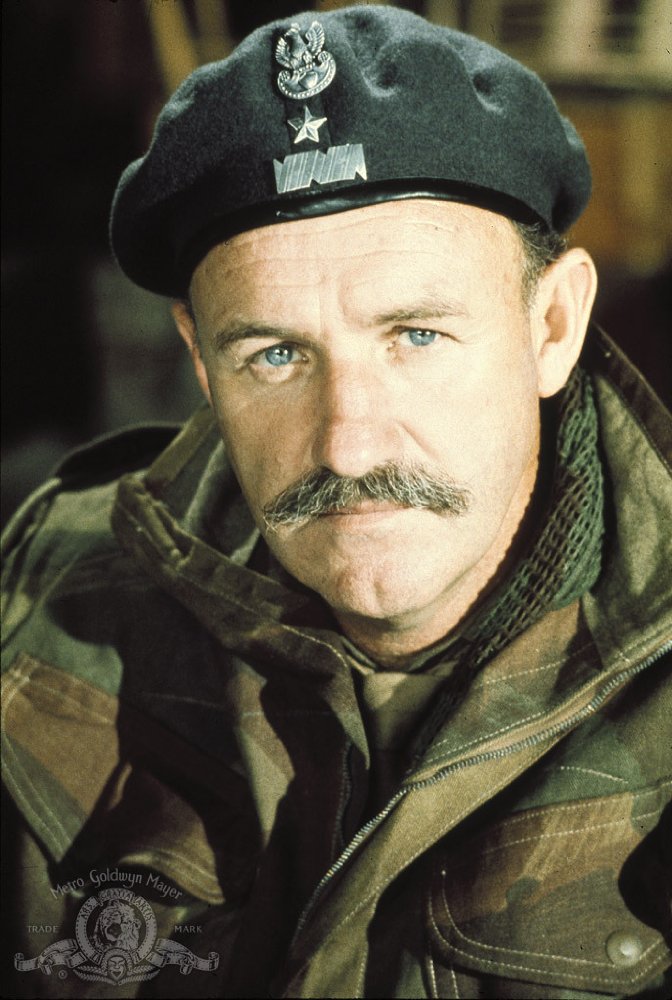
Operation Ends
After securing Nijmegen Bridge, XXX Corps waits several hours for its infantry to secure the town. Finally, Sosabowski’s troops enter the battle, yet they are unable to effectively reinforce the British at Arnhem. The Germans, now on full alert, intercept and gun down numerous Poles during their drop; only a handful survive to reinforce the British. After days of house-to-house fighting at Arnhem, pitted against crack SS infantry backed by panzers, the outgunned paratroops are captured or forced to withdraw. Arnhem itself is indiscriminately razed. Although Operation Market Garden is determined by Montgomery and his High Command to be 90% successful, most of those who actually carried it out feel quite differently. Urquhart escapes Arnhem with fewer than a fifth of his original 10 thousand crack troops; those who were too badly injured to flee stay behind and cover the withdraw, then give themselves up. Urquhart confronts Browning about his personal sentiments regarding the operation: does Browning think it was as well as Montgomery estimates? Browning’s reply (and the film’s last line of dialogue, not counting the Allied prisoners who sing Abide With Me en route to the German POW camp) contradicts his earlier optimism for Market Garden: “Well, as you know, I always felt we tried to go a bridge too far.”
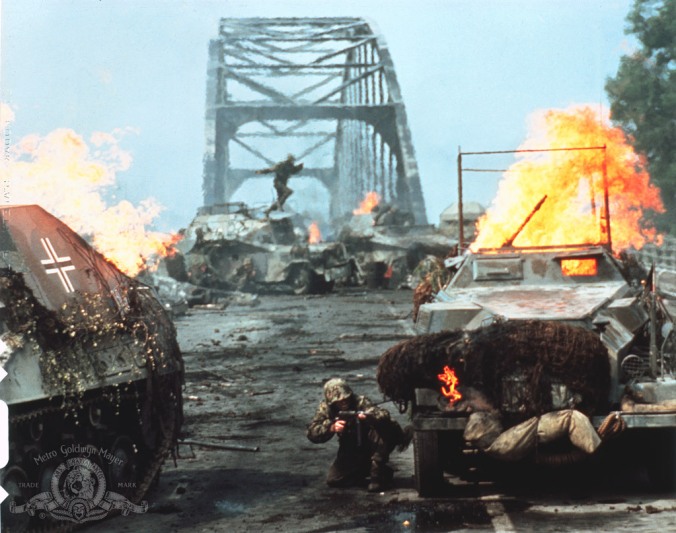
In the film’s final scene, Kate ter Horst (Liv Ullman) and her children are forced to abandon their bombed-out residence. Placing their belongings in a cart which is drawn by Dr. Jan Spaander (Laurence Olivier), they pass through their front yard – which has been converted to a cemetery for fallen Allied troops – and trek across the countryside to an uncertain future. One of the children brings up the rear, marching with a rifle-shaped branch he has found.
Under-rated war epic.
Quite a few bad things have been written about A Bridge Too Far. Richard Attenborough’s elephantine recreation of the battle for several strategically valuable Dutch bridges in the winter of 1944 is a star-studded, lengthy and exhausting film (and many critics at the time seemed to be of the opinion that it collapsed beneath its own weight). Almost thirty years on, the film is now viewed somewhat more favourably. It may feel 30 minutes too long, and the need for so many stars in so many tiny parts is questionable, but A Bridge Too Far successfully shows a fierce episode of the Second World War in all its chaotic glory.

Incredibly, there’s no use of the computer generated effects during the big battle scenes that it is relied upon in modern films like Gladiator and Troy. The scenes in this film were shot pretty much as you see them – so the 35,000 parachutists storming Holland, the river crossing led by Robert Redford under intense enemy fire, and other such staggering combat sequences were filmed with thousands of extras and a good deal of meticulous planning and preparation.
The film is based upon Operation Market Garden, an Allied plot hatched towards the end of 1944 with the intention of ending the war in Europe. The concept behind the plan was to drop 35,000 soldiers into Holland approximately 60 miles beyond the German lines, to seize six vital bridges, and to reinforce the paratroopers by sending in thousands of ground troops. However, various mishaps jeopardised the mission and eventually the Allies were cut off and had to withdraw, suffering severe losses.
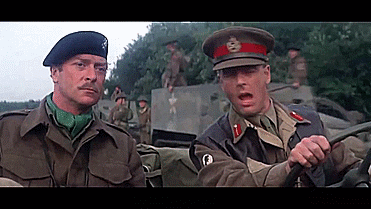
As stellar casts go, A Bridge Too Far still takes some rivalling. Among the many famous actors involved, these are just a few: Sean Connery, Robert Redford, Laurence Olivier, Dirk Bogarde, James Caan, Ryan O’Neal, Gene Hackman, Michael Caine, Anthony Hopkins and Elliott Gould. It seems pointless for some of the actors to be cast in these roles – true enough, Connery, Bogarde and Hopkins get decent roles and a fair bit of screen time, but was it really worth paying Redford $2,000,000 for his ten minute heroics? Could a decent actor have not handled the role for a fraction of that amount? Is Gene Hackman really the correct choice for Polish officer Major General Stanislaw Sosabowski? Should a light comic actor like Elliott Gould be doing his cigar-chomping “fun” turn in a movie as serious as this?
Luckily, the film is a big success on other levels. The cinematography is extraordinary; the music is suitably stirring; the potentially confusing story is handled with clarity and true-to-the-facts sensitivity; and amid the chaos a number of very memorable scenes emerge. A Bridge Too Far is a very good war film – maybe the biggest war film ever conceived (The Longest Day and Saving Private Ryan included) – and I feel that, although it has a few casting flaws, it is in almost every other department a great, great achievement.

What makes this movie so good is the realism, shown in every detail
![]()
Author: Philip Van der Veken from Tessenderlo, Belgium
29 September 2004
I’m a big fan of war movies and I already have a nice collection on DVD. One of them is A Bridge Too Far and I can only say that it is one of my favorites in this genre (if you can make a comparison between movies like A Bridge Too Far, Saving Private Ryan, All Quiet on the Western Front, Apocalypse Now… of course). What I really don’t understand is why this movie never was a big success in the cinema’s. Perhaps the people had enough of war movies … and Star Wars was very hip and new at that time of course, but personally I love this movie.

What makes this movie so good is the realism. In most of the war movies of that period, everybody speaks English. No matter if it is a German, an American,… In this movie everybody speaks the language he is supposed to speak. There even is a difference between the English of the Americans and the British. But of course the use of different languages isn’t the only thing that attracted me. Another good example is the fact that they didn’t try to make all the Germans look like brainless killers, monsters without any human feelings. The movie showes them the way they really were: good and hard fighters who cared about their comrades just as much as any allied soldier, but who didn’t just kill for fun. (Just for your information: I’m talking about the soldiers in the Wehrmacht here and not about the SS, even though not all SS-troops where that bad either. There are good and bad people in every army.)
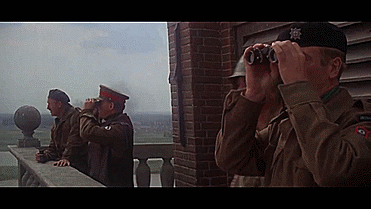
The effort which was put in this movie is shown in every detail. The uniforms, the weapons, the landscapes, the cities…, everything really gives you the feeling the director wanted to give an accurate vision on what happened during operation Market Garden. Images from the movie were even incorporated in a documentary on this subject. That probably shows better than anything else how good this movie really is.
You probably ask yourself if there really isn’t anything negative about this movie. Of course there is, but it never really bothered me. Therefore I reward this movie with a 9/10. Perhaps a little too high according to the average IMDb user, but for me it’s sure worth it.

“It’s All A Question Of Bridges”
Author: Michael Coy (michael.coy@virgin.net) from London, England
14 February 1999
“Quite frankly,” observes ‘Boy’ Browning, “this kind of thing’s never been attempted before.” But it has. In 1962, “The Longest Day” gave the epic star-studded treatment to the D-Day landings, and here we are, 15 years on, doing the same for the Arnhem debacle. It has to be said, the film looks great. From the gently-tinkling light fittings in the Dutch resistors’ home to the beauty of the tank tracks in perspective, this is a gorgeously-photographed movie.
In 1944, the German armies were being pushed back across the Low Countries. The Allies’ great strategic problem was the Rhine, the wide river which formed Germany’s western border. A daring plan was conceived which would overcome the Rhine obstacle and open the road to Berlin. ‘Market Garden’, as the plan was codenamed, involved parachuting spearhead units onto the great bridges over the Rhine and securing them for the critical few hours it would take for an armoured column to drive up and relieve them.

It is easy now to point to the flaws in ‘Market Garden’, but at the time it looked like a daring and viable alternative to slogging it out against the Siegfried Line. No-one had anticipated that the Dutch people would pour out onto the streets in throngs, thinking that they had been liberated, and thus bog down the armour. The intelligence indications of heavily-equipped German units in the zone were ignored because they were inconvenient. Critically, the plan allowed for only one solitary road to be available to the Irish Guards for the all-important northward thrust. The film illustrates very effectively the way in which a plan can develop its own momentum, regardless of the shortcomings which riddle it.

The sequence of the boarding and dropping of the paratroops is a thrilling spectacle, shot on a colossal scale. The German ambush which delays the rolling of the armoured column is another terrific action sequence. Attenborough keeps tight control of a big, complex story, and interlards the large-scale stuff with ‘human scale’ passages, like James Caan’s rescue of his buddy (incidentally, the tracking shot which follows his jeep through the forest is quite remarkable).

The fighting at Nijmegen is brilliantly-filmed. Note how the street on the British side grows increasingly littered with war debris as the battle rages. Robert Redford’s assault across the river is a symphony in olive drab, leading to a wonderful moment of exhilaration.
Whether the viewer finds the singing of “Abide With Me” moving or grossly sentimental will depend on personal taste, but the subdued ending is very satisfying. ‘Market Garden’ may have helped shorten the war and may have achieved most of its immediate objectives, but it has to be seen as a tragic mistake.
The film is slick, professional and very pleasing on the eye. One can’t help wondering, however, if this kind of ‘tank opera’ was worth the effort, given that “The Longest Day” had done it all so splendidly a generation earlier.

A FAILED GAMBLE
Author: Howard Morley (luke@morleys.demon.co.uk) from LONDON ENGLAND
26 June 2002
This video portrays with great precision in an almost acted documentary way the failed attempt in September 1944 to end WWII early based on the plan conceived by Field Marshall Bernard Law Montgomery of El-Alemain (with Eisenhower’s approval).The Allies by this time had advanced deep into Belgium almost to The Dutch border but the advance suddenly slowed due to their out-running lines of supply and their inability to take a servicable port intact nearer their front line.Supplies were still being transported from the won Normandy beachheads a distance of over 500miles.
The Plan involved dropping British, American and Polish paratroopers at strategic bridges in the Netherlands such as The Son, The Grave, Nijmegen, to be taken by the American 82nd and 101st Airborne and the prize, Arnhem to be taken and held by British paratroops.

Once all these bridges were captured and held, The British 1st Army would drive up the road linking them, thus giving the Allies a springboard to the Rhine and Germany.It was code-named “Operation Market Garden”, Market being the airborne drop and Garden the drive up the road.That was the theory. The planners overlooked,by ignoring seemingly on purpose aerial reconnaisance photos which indicated that Dieter’s SS Panzers were resting and re-equipping in the Arnhem area. The Allies’ communications equipment had not been tested thoroughly enough e.g. “walkie-talkies” worked in open country but what about in built-up areas?Did they have the right sort of crystals fitted?The daily air drops to re-supply lightly armed paratroops could not work if the paras were not in their coded/designated drop zones. Amazingly after the strategic withdrawal from Arnhem, Montgomery is purported to have said it was “90% successful”!

This film, directed by Richard Attenborough, was made in 1977 with a galaxy of well known stars i.e.:Dirk Bogarde as General Boy Browning,Lawrence Olivier, Liv Uhlman,Ryan O’Neal, James Caan, Robert Redford, Gene Hackman,Anthony Hopkins, Sean Connery and Michael Caine.They all play historical figures but for me the most effective was Edward Fox playing General Sir Brian Horrocks.The latter presented a UK TV series on WWII in the 1960’s and Fox’s mannerisms and speech patterns were unerringly similar.Please bear in mind that since the recent film “The Saving of Private Ryan”, special effects in war films have gone up a quantum leap, e.g. the havoc that bullets/bombs/morters etc can wreak on the human body.So you are looking at 1977 special effects.
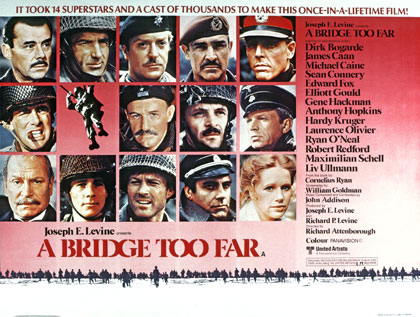
Nevertheless the equipment including the DC3’s and filming of the actual paratroopers drop into The Netherlands was most impressive.Sometimes the dialogue is a little stilted to modern tastes but this is or should be speech patterns from 1944.It was General Boy Browning who stated “…but sir, I think we may be going a bridge too far” when he met with the Allied top brass to oversee the plan which he had to execute.This is certainly one of the seminal WWII war films and the only one which concentrates on this failed strategy to liberate the Low Countries.
If you can forget the famous actors and get into their characters and have a sense of modern history, this long film will stimulate you.
